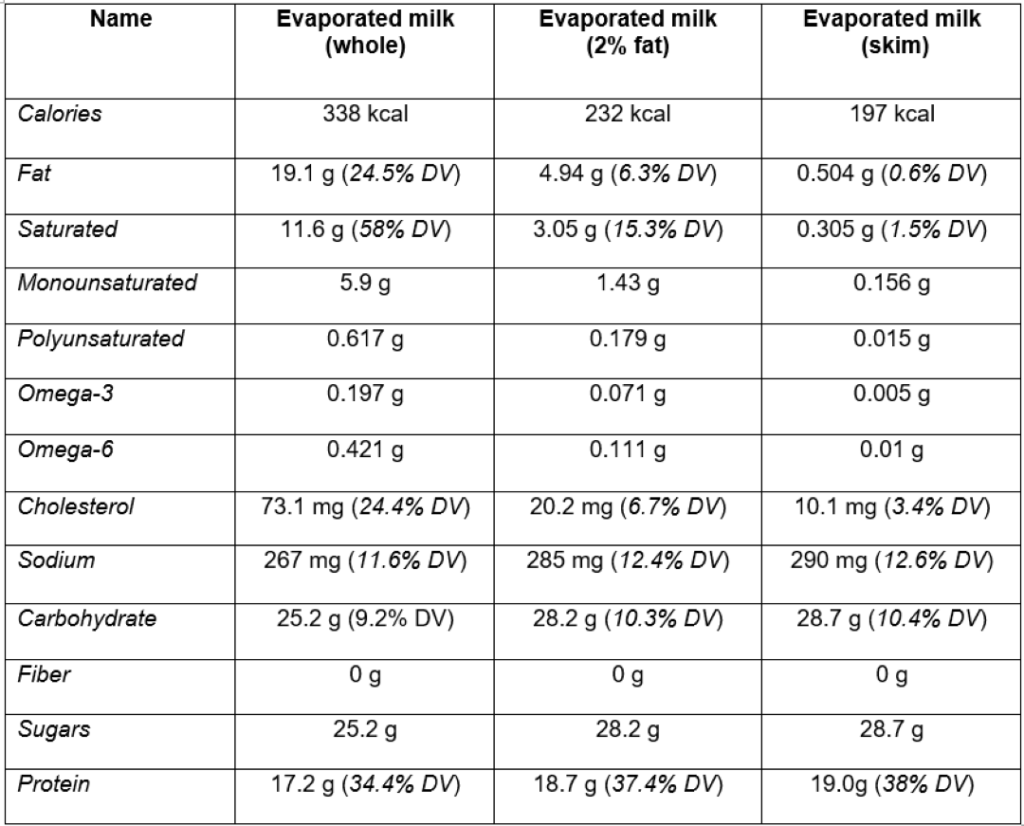Evaporated Milk: What Is It?
Simply regular dairy milk that has been thickened by evaporation is typically referred to as evaporated milk. Milk must be heated for a sizable portion of its water content to evaporate to create evaporated milk. The method for creating evaporated milk is still the same today; fresh milk is simmered slowly over low heat to remove around 60% of the water. After that, the milk is homogenized to integrate all the fat molecules and prevent their separation over time. This contributes to the prolonged shelf life of evaporated milk. vitamin D supplemented, maybe with extra vitamin A, vacuum-sealed in cans, and heated to a sterilizing temperature of 240 to 250 F.
Heat is used to turn ordinary milk into evaporated milk, which has a slight caramel flavor and is thicker and creamier. Due to its consistency, evaporated milk is a well-liked, low-fat alternative to half-and-half or heavy cream are also available. There are various varieties of evaporated milk sold by companies like Nestle, but the most popular one has only 1.5 percent fat and other ingredients like vitamin D.
Rules and regulations for Evaporated Milk (EM)
The Codex Alimentarius is an international organization that oversees the nutritional makeup of EM. In contrast, the Code of Federal Regulations (CFR) supervises it in the United States. The CFR specifies that evaporated milk must have a minimum of 6.5% milkfat, 16.5% milk solids-not-fat (MSNF), and 23% total milk solids by weight.
Each country’s Codex Alimentarius and national laws set standards for evaporated milk’s composition. The two most widely used specifications are the British Standard, which calls for a minimum of 9% milk fat and a minimum of 31% total milk solids, and the US Standard, which calls for a minimum of 7.9% milk fat and 25.9% total milk solids. The Codex standard, which calls for a minimum of 7.5% milk fat and 25% total milk solids, is the one that is most frequently used in international trade. The concentration factor so varies between 2.0 and 2.5. The Codex permits the addition of milk permeate, lactose, or milk retentate to change the solids-not-fat protein content to a minimum of 34%, but not to alter the casein-to-whey protein ratio. However, local laws in some nations can still restrict the standardization of protein.

Vegetable fat is replacing conventional milk fat in EM
The technical name for such a product is “filled evaporated milk,” but the Codex name is “blend of evaporated skimmed milk and vegetable fat,” which is also frequently used. The most popular oils are palm or coconut oil, though oils with a high content of polyunsaturated fatty acids can also be employed. The stability of oxidation is crucial, especially given the high polyunsaturated fats.
In order to regulate heat stability, sodium orthophosphate is typically added. This can also be accomplished by using soy lecithin, calcium chloride, or calcium carbonate. To prevent age gelation, polyphosphates may be added to UHT-sterilized EM. The maximum addition allowed by the Codex is 0.2% when used separately, or 0.3% when used in combination. To delay creaming, k-Carrageenan (0.005%) is occasionally used.
Nutrition Facts
Similar to conventional dairy milk, there are several types of EM, each with a varied amount of fat. The fundamental nutritional information for EM products per typical cup serving is depicted in the following table.
The USDA’s Food Data Central nutrition database is the source for all nutritional information. These USDA statistics and the FDA’s suggested daily values were used to generate daily values (% DV).

As you can see, all types of EM include twice as many calories, carbs, and protein as whole milk, and their varying fat contents.
- In comparison to fresh milk, which contains 21%, 6%, and 8% of the DV for calcium, magnesium, and zinc per cup, all three types of EM have over 50% of the Daily Value (DV) for calcium per cup, 15% of the DV for magnesium, and 18% of the DV for zinc.
- Vital vitamins and minerals are abundant, a variety of vitamins are present, but riboflavin, vitamin A, vitamin B12, and choline concentrations are notably high. According to the daily values and USDA data for whole evaporated milk, it contains significant amounts of phosphorus, potassium, magnesium, sodium, and selenium.
Are There Any Additional Ingredients in Evaporated Milk?
Milk is the main component of EM, hence no other sugars or fats should be included. Depending on the particular brand, it may have added vitamin A and D. Sodium phosphate, which prevents milk from coagulating, may be present in some brands of EM.
What Sets Evaporated Milk Apart from Condensed Milk?
Condensed milk and evaporated milk often get confused for a reason: The same method is used to create both evaporated and condensed milk, which are concentrated milk products that may be stored for an extended time. The components of the two are different from one another: Condensed milk has additional sugar, which affects the overall taste, appearance (color), and consistency.
1. Sweetness
Condensed milk is sweetened with additional sugar, which serves as a natural preservative, while EM is unsweetened. Fresh dairy milk naturally contains about 5% sugar, primarily in the form of lactose, making EM about 10% sugar by weight. Most sweetened condensed milk has a sugar content of 55%.
2. Taste
Gently caramelized evaporated milk for a softer, richer flavor. Condensed milk does not require heat sterilization as EM does because of its high sugar content. It does not produce the same caramelized flavor as evaporated milk as a result.
3. Color
Due to the concentration of lactose and protein that happens during cooking, EM has a tan tint. The high sugar content in sweetened condensed milk gives it a lighter tint.
4. Texture
Condensed milk imparts a deep creaminess, whereas evaporated milk gives baked items like pies and cakes a lighter, airier texture.
5. Comparison
The calorie and sugar content of a cup portion of evaporated milk and condensed milk-
- A cup of evaporated milk (whole) contains 338 calories and 25.2 g of sugar.
- A cup of condensed milk (whole) contains 976 calories and 165 g of sugar.
What Makes Evaporated Milk Different From Powdered Milk?
Both powdered milk and evaporated milk are handy ways to consume more milk each day. One or both of these can be found in many processed foods that you can buy at the store. Sometimes it’s one, other times it’s the other.
Dry milk, commonly referred to as powdered milk, is a powder. It is a dairy product from which the liquid has been taken out. EM is canned cow’s milk and is liquid. Unsweetened condensed milk is another name for it.
While powdered milk is in a dry, powder state and can be reconstituted with water, evaporated milk is in a liquid form. EM has a sweeter, caramel-like flavor because its lactose has been cooked and slowly caramelized, in contrast to powdered milk, which is mildly sweet because of lactose. In contrast to powdered milk, the flavor will be distinct and more “cooked.” Because milk solids contain no water or moisture, they may taste more concentrated if the milk is not reconstituted. This indicates that the powdered milk is not sweetened (unless otherwise stated on the label), but that it is sweeter due to the increased milk solid content per serving.
Both EM and powdered milk are widely available in supermarkets, and if stored properly, both are excellent for longer journeys or regions where fresh milk is difficult to come by.
Are There Any Advantages to Evaporated Milk Over Regular Milk?
EM can offer several advantages over conventional dairy milk. Here is a summary of these potential advantages.
1. Higher Nutrient Content Per Cup
The protein, vitamin, and mineral content of EM are roughly twice that of milk. Because of this, half a cup of EM has the same nutritional content as a full cup of ordinary milk.
In general, people don’t generally consume plain EM; it’s more commonly utilized in recipes. However, people who need to acquire nutritional value from lower volumes of liquid may find EM useful because of its concentrated nutrient prprovision
2. Long Shelf Life
But after it’s been opened, EM needs to be kept in the fridge and used within 3 to 4 days.
3. Suitable for Recipes
There are valid reasons why some recipes would specifically state that EM should be used in place of ordinary milk. For instance, a certain recipe might call for the fat, protein, and carbohydrate content of milk, but not excessive liquid. In other words, adding a cup of whole milk could make the recipe’s consistency excessively runny. However, EM can deliver the same amount of liquid for around half the content as ordinary milk. This allows for the addition of the necessary amount of milk solids to
The recipe can now be amended to include the required amount of milk solids without having to add as much water as before.
4. Can Serve as a Milk Replacement
It isn’t a life-for-like milk substitute because of the viscosity, thickness, and sweetness of EM. To make it resemble milk, however, it can be diluted with water (about one part EM to one-part water).
5. Better for Storage and Shipping than Fresh Milk
The fact that EM is simpler to ship and store than fresh milk is another advantage that could be gained from using it.
Shipments of evaporated milk can supply the local populace with milk in places where fresh milk isn’t always readily available.
Possibilities for Improvement
Evaporated milk has a possible drawback, similar to most food products: a higher lactose content. As opposed to ordinary milk, It has a higher volume concentration of lactose and milk proteins. While EM has a lactose level of 11%, fresh cow milk has a lactose content of 4-5% by weight. For many lactose intolerant people, this is probably not a suitable choice because it has more than twice as much lactose as regular milk. This further restricts market expansion.
In addition to the lactose issue, it is important to note that EM contains twice as many calories as milk. Simply put, the portion size is important because it is simple to consume too much. In light of this, “lactose-free evaporated milk” products would do well to address this problem.
The Potential for Evaporated Milk Globally
The market for evaporated milk was valued at USD 957.9 million globally in 2020, and it is anticipated to increase to USD 1,162.8 million by 2027. A growth of 2.8% is predicted for the market over the forecast period. By 2027, there will be an anticipated 403,451.8 tonnes of evaporated milk on the market, expanding at a CAGR of 2.5%.
A shelf-stable product prepared from canned cow’s milk is evaporated milk or unsweetened condensed milk. It has a shelf life of roughly 18 to 24 months and is accessible in liquid form.
The industry is anticipated to be fueled by evaporated milk’s superior nutritional characteristics over ordinary milk.
The global food and beverage business is expanding quickly. This is increasing consumer demand for healthier alternatives to common food items like milk. There are several uses for EM in the industry. Smoothies, coffee, creamy soups, chowders, porridge, and savory sauces are just a few dishes that use it. It is projected that the expansion of the market will be driven by all these applications and the expanding food and beverage sector.
References-
Nieuwenhuijse, J.A. (2016). Concentrated Dairy Products: Evaporated Milk. Reference Module in Food Science. doi:10.1016/b978-0-08-100596-5.00695-8.
Joseph, M. (2022). What Is Evaporated Milk? Nutrition, Benefits, and Uses. [online] Nutrition Advance. Available at: https://www.nutritionadvance.com/evaporated-milk-nutrition/
www.businesswire.com. (2021). Global Evaporated Milk Market (2020 to 2027) – Focus on Skimmed and Whole Evaporated Milk – ResearchAndMarkets.com. [online] Available at: https://www.businesswire.com/news/home/20210906005050/en/Global-Evaporated-Milk-Market-2020-to-2027—Focus-on-Skimmed-and-Whole-Evaporated-Milk—ResearchAndMarkets.com



Pros of Evaporated Milk to Consider